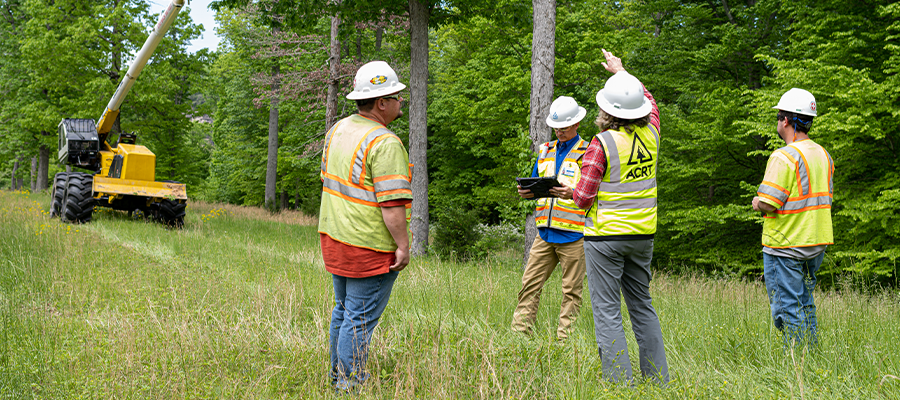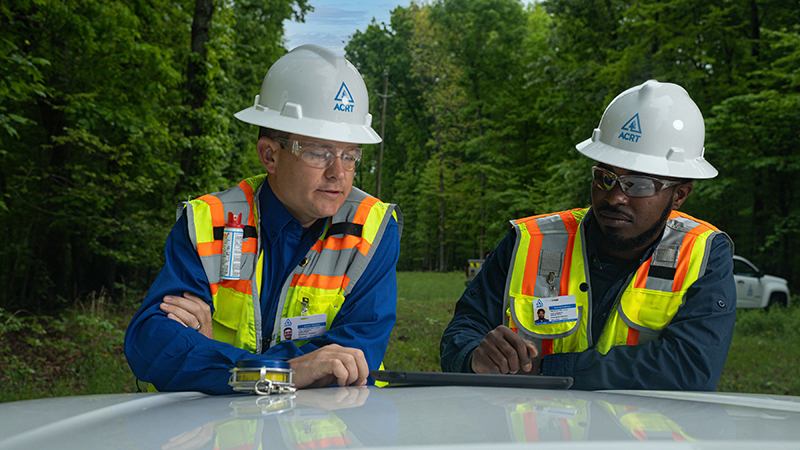- Vegetation Management Services
- Industries
- In Your Neighborhood
- About
- Careers
- Webinars
- Articles
Developing an Effective Safety Audit Program for Tree Crews

Developing an Effective Safety Audit Program for Tree Crews
The arboriculture industry presents unique challenges when it comes to ensuring safety and compliance, particularly for contract tree crews. These crews work in environments where hazardous equipment, proximity to power lines, and unpredictable conditions are part of their daily routines. The stakes are high — not only for the workers but also for the communities they serve. Establishing a robust safety audit program is one of the most effective ways to mitigate risks, foster a culture of safety, and improve operational efficiency.
Safety audits go beyond basic inspections. They serve as a structured approach to identifying risks, evaluating compliance with safety standards, and providing actionable feedback to improve practices. This article explores the critical components of an effective safety audit program, offering practical insights for organizations looking to enhance safety outcomes for contract tree crews.

Master Work Planning with CUFs
See how CUFs transform work planning and auditing.
Understanding the Scope of Safety Audits
To design an impactful audit program, it is crucial to understand the difference between basic safety checks and comprehensive evaluations. Basic audits often focus on surface-level aspects, such as verifying that fire extinguishers are properly charged or ensuring that wheel chocks are correctly positioned under vehicle tires. While these checks are necessary, they represent only the starting point for a well-rounded audit program.
Advanced safety audits delve deeper, assessing more complex areas like climbing techniques, knot selections, and the proper use of roping and rigging equipment. These audits may also evaluate whether crews working with cranes or other machinery are adhering to the manufacturer’s safety thresholds and best practices.
The role of the auditor can vary as well. Some organizations employ embedded auditors who work alongside crews from the start of the day to its conclusion, providing real-time feedback on safety and quality practices. Others may rely on external auditors to bring a fresh, unbiased perspective. Both approaches have their merits, but the common goal remains the same: to ensure that safety practices align with industry standards while fostering continuous improvement.
Identifying the Need for Safety Audits
Before implementing a safety audit program, organizations must determine its necessity and potential impact. Safety audits often emerge as a response to specific challenges, such as a rise in workplace injuries, near-misses, or public complaints about crew operations. For instance, negative scrutiny from regulators or public utilities commissions can pressure organizations to improve safety protocols proactively. The urgency of such measures is underscored by OSHA’s report of 5,486 fatal work injuries in 2022, highlighting the critical need for proactive safety initiatives in mitigating risks.
In some cases, the need for audits is driven by external factors like media coverage. A single incident, such as a civilian breaching a poorly marked work zone, can escalate into bad press that tarnishes the organization’s reputation. Safety audits help organizations stay ahead of such risks by identifying and addressing vulnerabilities before they escalate.
Cultural issues within the workforce may also necessitate safety audits. For example, a contractor crew might have the technical skills to perform their tasks but lack consistency in safety practices. Similarly, internal crews that double as line department personnel may require targeted training and oversight to ensure compliance.
Setting Clear Goals and Allocating Resources
Establishing clear goals is essential for the success of any safety audit program. While a zero-incident rate may seem ideal, it is not always realistic. Instead, organizations should focus on measurable objectives, such as reducing injury rates by a specific percentage or improving compliance with regulatory standards over a defined period.
Resource allocation plays a pivotal role in achieving these goals. Implementing a safety audit program often requires financial investment, whether for hiring third-party auditors, purchasing equipment, or developing data collection platforms. Organizations must decide whether to rely on internal resources or outsource to external experts.
Third-party auditors offer the advantage of impartiality, providing unbiased evaluations that internal teams might overlook. However, internal audits can be equally effective when carried out by well-trained staff. In some cases, neighboring cooperatives may collaborate, pooling resources to hire a full-time auditor who serves multiple organizations. This approach can reduce costs while maintaining high standards.
Designing a Comprehensive Audit Framework
An effective audit framework combines meticulous planning with adaptability. The first step is choosing a data collection platform that meets the organization’s needs. While paper-based systems may suffice for smaller operations, digital solutions such as cloud-based databases offer greater efficiency and scalability. These platforms enable auditors to compile data in real-time, generate automated reports, and identify trends that inform decision-making.
Training is another cornerstone of a successful audit framework. Auditors must possess a deep understanding of the specific risks and practices associated with tree trimming. For instance, they should be able to assess whether climbing knots are tied correctly, whether rigging equipment meets load requirements, and whether crews are operating within minimum approach distances to power lines. Without this technical expertise, auditors may struggle to provide meaningful feedback or gain the trust of the crews they evaluate.
Tailoring audits to the unique risks of different roles is equally important. Tree trimming crews, for example, face hazards related to falling limbs, electrical exposure, and improper rigging. Herbicide applicators, on the other hand, must adhere to strict guidelines for chemical handling and disposal. By addressing the specific needs of each role, organizations can ensure that their audit programs are both comprehensive and relevant.
Fostering a Culture of Safety
While audits are a powerful tool for identifying risks, they must be part of a broader effort to cultivate a culture of safety. Training and education are critical in this regard, equipping workers with the skills and knowledge they need to perform their jobs safely. Regular feedback sessions provide another avenue for improvement, enabling crews to address deficiencies and build on their strengths.
Retention is another area where safety plays a significant role. A safe work environment not only reduces turnover but also attracts new talent to the industry. In an era where skilled labor is in short supply, retaining experienced workers and creating an appealing workplace culture are essential for long-term success.
Public perception also matters. Organizations that prioritize safety audits and communicate their commitment to safety through press releases or social media can counter negative narratives and enhance their reputation. Customers and stakeholders are more likely to support organizations that demonstrate accountability and transparency.
Leveraging Innovation and Collaboration
Technology and collaboration offer significant opportunities for enhancing audit programs. Digital tools, such as web-based dashboards, allow organizations to monitor safety performance in real-time. These dashboards can highlight key metrics, such as compliance rates and injury trends, in a visually accessible format.
Collaboration between organizations can also yield valuable benefits. By sharing resources and expertise, cooperatives and smaller utilities can implement safety audit programs that might otherwise be cost-prohibitive. This cooperative approach not only spreads costs but also fosters a shared commitment to industry-wide safety standards.
Conclusion
The development of an effective safety audit program requires careful planning, adequate resources, and a commitment to continuous improvement. By addressing specific risks, fostering a culture of safety, and leveraging technology, organizations can protect their workers while enhancing their operational efficiency.
Ultimately, safety audits are not just about compliance — they are about creating a workplace where every worker feels valued and secure. In doing so, organizations not only reduce risks but also strengthen their reputation and position themselves as leaders in the arboriculture industry.
Ready to enhance safety and compliance for your tree crews? Contact ACRT today to learn how our expert safety audit solutions can protect your team and improve your operations. Let’s build a safer future together!
Related Articles

Servant Leadership in Utility Vegetation Management By C. Troy Ross, President, ACRT and ACRT Pacific On a chilly Monday morning, a utility vegetation management crew gathers for their weekly briefing. Instead of launching into instructions, their supervisor begins by asking each team member how they’re doing. One mentions a child’s illness, another shares excitement about[...]
Read More
Turning Vegetation Waste into Opportunity By Aana Agrawal, Sustainability and Resilience Manager, EnviroScience The utility vegetation management (UVM) sector plays a crucial role in ensuring the smooth transmission of power across regions and cities by keeping plant growth under control within the vicinity of transmission and distribution lines. However, unrefined vegetation maintenance practices often focus[...]
Read More
Reflections from Will Nutter Silver Shield Award Recipients By Bob Urban, Senior Manager, ACRT Services In an industry where the stakes are high and every decision can have life-altering consequences, leadership in utility arboriculture isn’t just a managerial function; it’s a calling. Nowhere is this more evident than in the recipients of the Will Nutter[...]
Read More
The Electric Butterfly: Reconnecting with Nature on the Edges By Ryan Meccage, Business Development Manager, ACRT Services In an age dominated by smartphones, constant connectivity, and algorithm-driven content, we’ve never been more digitally immersed. Yet somehow, we’ve also never felt so far removed from the natural world beneath our feet. The urge to step away[...]
Read MoreRecent Posts
- Alex Fields Awarded ACRT Safety Challenge Coin 20th Nov 2025
- Servant Leadership in Utility Vegetation Management 12th Nov 2025
- ACRT Honors Our Veterans 10th Nov 2025
- Anna Davis Awarded Safety Challenge Coin 04th Nov 2025
- ACRT Senior Consulting Utility Forester Recognized as Safety Superstar 15th Oct 2025
Categories
The Leader In Vegetation Management
We are all about people, and we put safety first. Ready to work with our well-trained team?